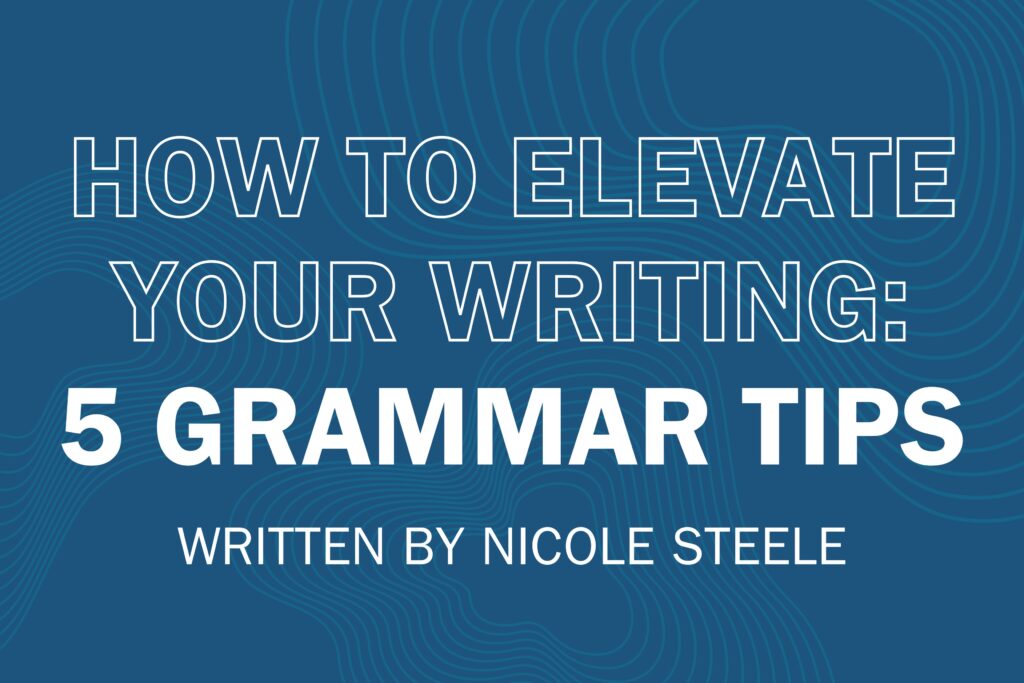How to Elevate Your Writing: 5 Grammar Tips

“I think the written word is probably the best medium of communication because you have time to reflect, you have time to choose your words, to get your sentences exactly right.”
As author and Oxford professor Richard Dawkins stated, writing is powerful. With it, we have the ability to take people through journeys of either exploring a story or learning new information. However, how effective is that story if readers are confused or annoyed by misused grammar?
With a couple of simple tweaks in your writing style, you can take your story-telling capabilities to the next level. As an editor, I find myself overly passionate about the importance of grammar. So, please indulge me as I use the excuse of National Punctuation Day to geek out over grammar and share a couple of the common edits I make to articles.
Coordinating Conjunctions
I have a lot of people tell me, “I have no clue how to use commas. I always just guess.” To some extent, you can do a lot through guessing. We tend to have an innate understanding of when someone should pause while talking, which translates to an adequate instinct on when to use commas in writing. However, while there are many uses for commas, I’ve noticed that they are commonly forgotten after coordinating conjunctions.
What are coordinating conjunctions? As Grammarly states, “a coordinating conjunction is a word that joins two elements of equal grammatical rank and syntactic importance.” The seven coordinating conjunctions are “for,” “and,” “nor,” “but,” “or,” “yet,” and “so,” which can be remembered by using the acronym FANBOYS.
When using a coordinating conjunction to connect two independent clauses — that is, two ideas that could stand alone as complete sentences — one must always use a comma before the coordinating conjunction.
For example, you may have these two independent clauses:
“I need to go to the store.”
“The closest store is 20 minutes away.”
You can connect the two simple sentences with a coordinating conjunction to make them more dynamic, but you must not forget the comma as you do so. The new sentence would be as follows:
“I need to go to the store, but the closest one is 20 minutes away.”
Semicolon
Now that we’ve figured out how to use a coordinating conjunction and the comma that goes before it, let’s talk about how we can replace coordinating conjunctions. Instead of using a coordinating conjunction to connect two independent clauses, you may want to further diversify your sentence structures by using a semicolon in its place. For instance, let’s look back at our coordinating conjunction sentence:
“I need to go to the store, but the closest one is 20 minutes away.”
You can change it to this:
“I need to go to the store; the closest one is 20 minutes away.”
Another way to use semicolons is to prevent readers from getting lost in the commas if you already have a lot in a sentence. While commas denote a short pause and periods denote a long pause, writers can use semicolons for medium-sized pauses. Here’s one example of that:
“I went to the store to get bread, butter, and milk; but they ran out of milk.”
Since “but” is a coordinating conjunction, it demands some sort of punctuation before it. However, if we put a comma before “but,” the number of commas may get confusing; therefore, we use a semicolon to break up the sentence to make it easier for readers to understand. Another example of using a semicolon in a sentence with lots of pre-existing commas would look like the following:
“Today, I went to the store to get bread, butter, and milk; the pharmacy to pick up my prescription; and the laundromat to wash my daughter’s, son’s, and my clothes.”
This sentence lists the different activities I did today, two of which also include lists. Without semicolons, the reader might not know when I switched from listing the places I went to today to listing the things I did at those places. In this case, a writer can use semicolons as medium-sized pauses to break up the larger ideas.
These are just two common ways I love leveraging semicolons, but there are also quite a few other uses for semicolons; you can learn more by visiting the University of Wisconsin-Madison’s Writing Center.
Em Dashes
Think of em dashes as the professional world’s parenthesis. Writers can use em dashes to add information to a sentence that — while still good to include — is not vital for the sentence to be complete. For example, this is an entirely complete sentence:
“She went to the store to get bread, butter, and milk.”
One can add more information to the sentence by using em dashes:
“She went to the store — which was about 20 minutes away — to get bread, butter, and milk.”
Both commas and parentheses would also work in replace of the em dashes, but parentheses tend to be more informal, and the number of commas may confuse the reader. However, as you’re writing, you must be careful not to mistake the em dash with the en dash or hyphen. PR Daily explained the difference between the three punctuation marks in one of their recent articles.
Periods
Hopefully, I should not need to teach you what a period is or how to use it. Still, it is worth noting that periods are more formal than exclamation marks and still fully capable of conveying emotion. Therefore, in formal settings, I highly encourage authors to step away from the exclamation points and stick to periods.
Oxford Commas
Whenever people ask me what my biggest pet peeve is, one of my top two answers is when people don’t use the Oxford commas. Though — while I hate to admit it — the oxford comma is actually optional.
The Oxford comma is the comma that comes before the final item in a list. Let’s explore this concept by reflecting back on our errands example yet again:
“She went to the store to get bread, butter, and milk.”
The oxford comma would be the comma before “and,” but the sentence would also be acceptable if it were written without the final comma, as seen below:
“She went to the store to get bread, butter and milk.”
The reason I so passionately argue for the Oxford comma, though, is for clarity in more complex sentences. For example, if someone is grouping items in a list and does not use the Oxford comma, the “and” may get mistaken as being used to group two items as one instead of listing off the final items. Here is an example:
“She went to the store to get vanilla and chocolate cake mix, butter and milk.”
Technically, the Oxford comma is not needed in that sentence; however, that makes the “and” in “vanilla and chocolate” look identical to the “and” that separates “butter” and “milk,” which confuses the reader when they realize that the butter and milk should not be listed as one item. Therefore, I argue that the sentence reads better with the Oxford comma:
“She went to the store to get vanilla and chocolate cake mix, butter, and milk.”
Even if you decide not to use the Oxford comma, implementing the other grammar tips in your writing will elevate your skills. With these stylistic choices, your writing will become grammatically correct, dynamic, and professional, which is the perfect start to effective storytelling.

Nicole Steele, PRSSA 2022-2023 National Vice President of Brand Engagement, is a junior at Biola University majoring in public relations with a double minor in communication studies and biblical & theological studies. She found her passion for public relations by volunteering in a branch of the Boy Scouts of America known as Venturing, where she currently serves as the founder and editor in chief of their national publication. She has also practiced PR in a variety of other positions, including as the communications intern at Benchmark and the account executive at her school’s PRSSA-affiliated, Student-run Firm. If you’re interested in writing a future Progressions article or simply want to connect with Nicole, feel free to reach out via email or LinkedIn.
